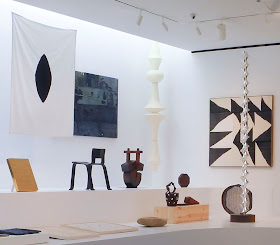Untitled 54, ink and egg tempera on Gampi smooth paper, 10 3/4 x 7 1/2 in.
In the past few years I've been a pushover for art influences: they've gotten me started on entirely new bodies of work. It began four years ago with seeing the exhibition of the Hours of Catherine of Cleves at the Morgan Library. In the blog post I wrote about the show, link above, I wrote "After seeing this beautiful show, I am thinking about pulling out [the] pieces of parchment [that I had in my flat files]" Well, I did pull them out, did paint on them, and fell in love with the material; I gave up painting on panel and began small, book-sized paintings on parchment. After being excited by the possibilities of printmaking at a print show at MoMA in 2012, Print/Out, I began to make prints using cardboard plates, and then potato prints. A couple of weeks ago, the show I saw at Pace Gallery, "Mingei are you here?", which I wrote about here, inspired me to think of new ways to approach my potato prints. The works of James Lee Byars and Lee Ufan prodded me in new directions: drawings by Byars of simple shapes floating in an expanse of Japanese paper made me think of doing something similar.
Untitled 54 detail
Byars sometimes worked with gold colored sculpture so I added gold paint to two of my prints.
Untitled 55, ink and egg tempera on Akatosashi paper; 2 panels, each 7 1/2 x 18 in.
This piece of mine is an out and out homage/theft of the long, narrow drawing by Byars, here shown with Japanese peasant objects:
Untitled 55 detail
I painted a thin gold line around the shapes stamped using a potato dipped in ink.
Untitled 56, ink on Akatosashi paper; 4 panels, each 14 3/8 x 11 1/2 in.
Here is another empty piece. I added a small curve at the bottom right, as a way to say "yes, I know there's all this empty space....". Honestly, I don't know if this works or is silly, but I had to try.
Untitled 56 detail
When you are looking at the actual print, you are more aware of the variation and incident in the color and transparency of the ink, so it gives a bit more weight to the image.
Untitled 57, ink on Twinrocker paper; 4 panels, each ca. 5 1/2 x 14 in.
I was thinking of Japanese screens while making 57. Last year there was a beautiful show at the Met about the Rinpa aesthetic in Japanese art, which I wrote about here. Seeing that show also influenced my potato prints and it was there that I began to think more about how careful placement of shapes can animate empty spaces.
Untitled 58, ink on Twinrocker paper, 21 3/4 x 14 1/8 in.
These soft, curving, organic shapes were inspired by two works by Lee Ufan in the exhibition at Pace; they are nothing like his work, but I was trying to emulate his spirit, as in the curving, calligraphic forms in the painting on the right:
Untitled 58 detail
For me, so much of the character of the prints resides in the paper surface and in the irregular way the ink sits on that surface, its transparencies and shifts of color. I feel very grateful to be able to see art that inspires me and pushes me toward new ways of seeing.

















































